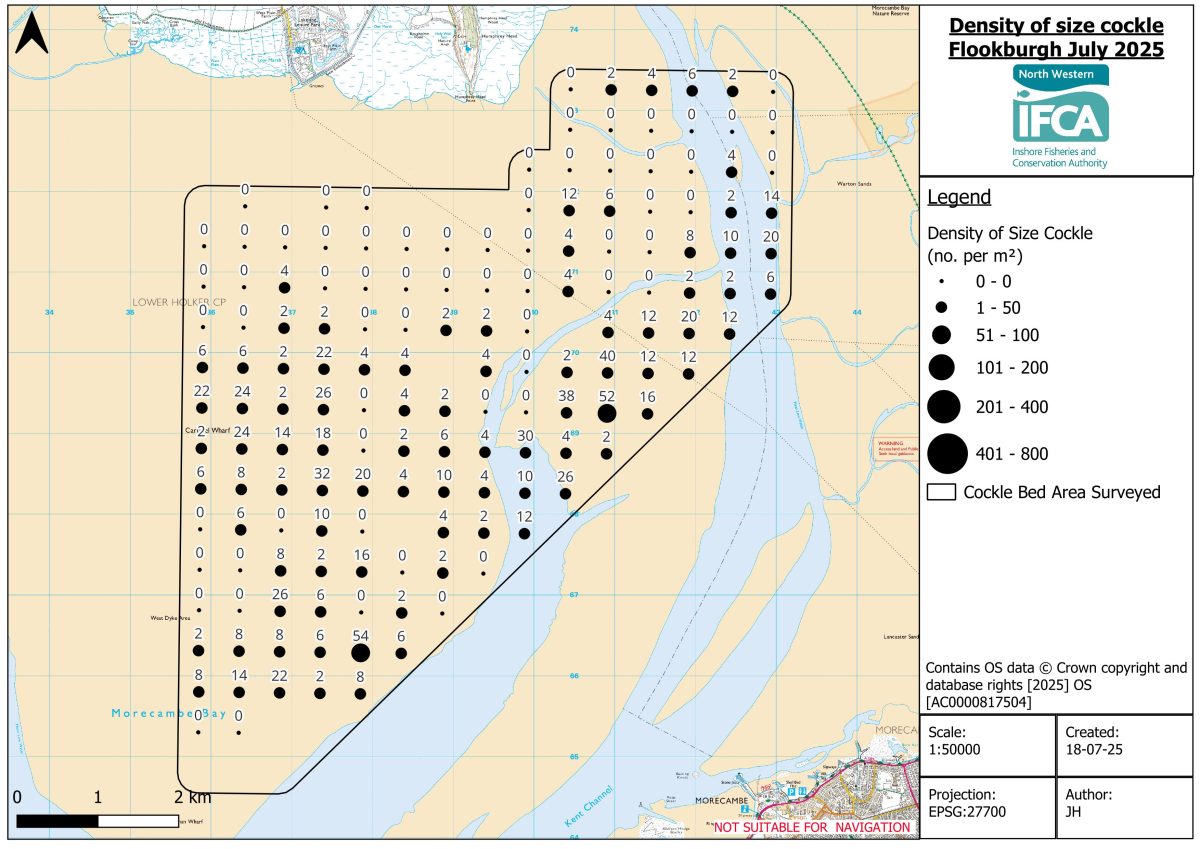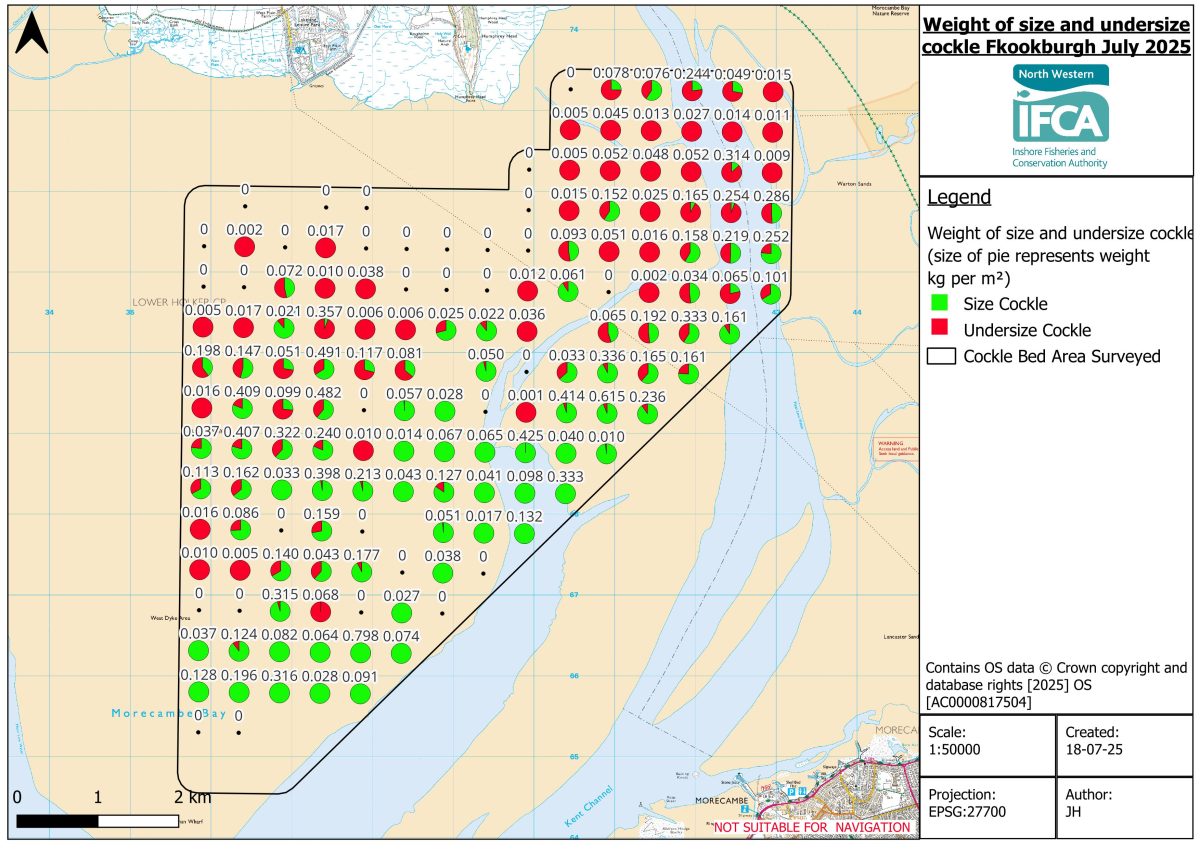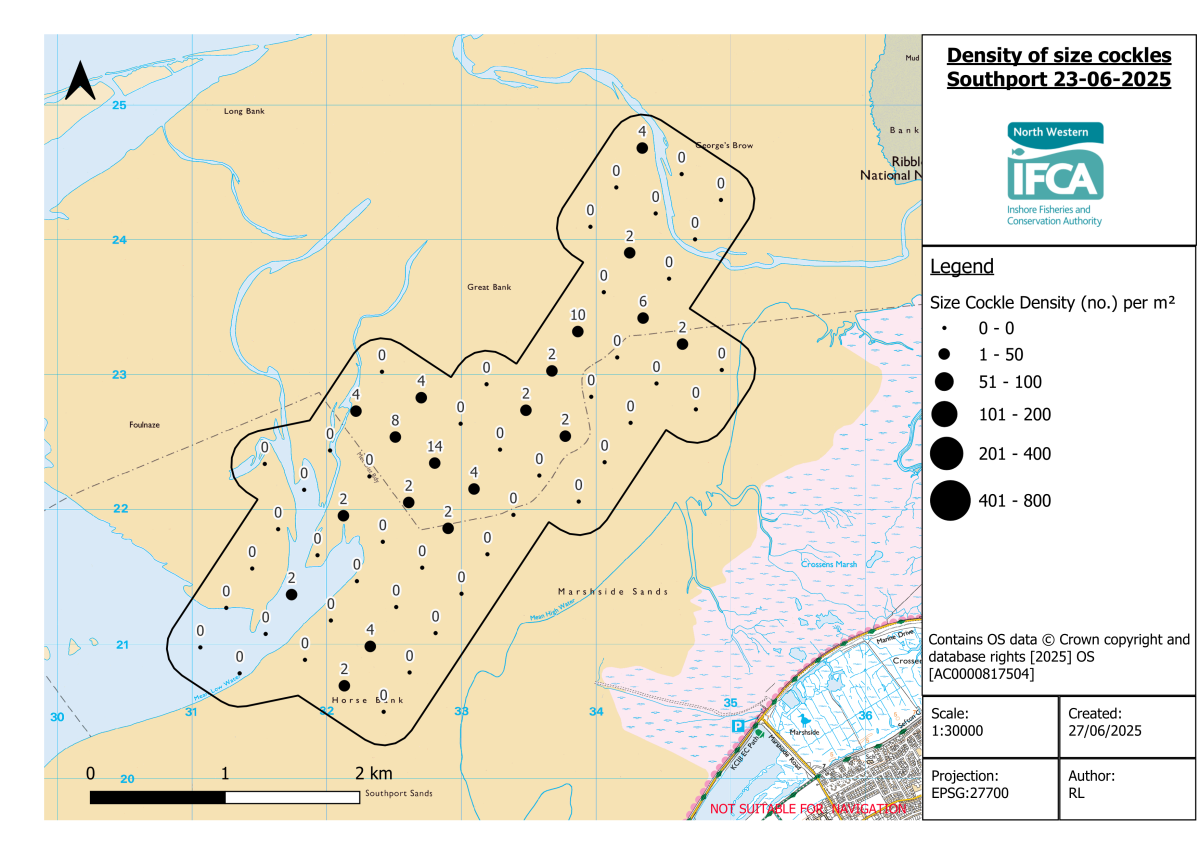NWIFCA 2025 District Cockle Fishery Recommendations
NWIFCA officers completed surveys of the District cockle beds between June and July 2025.
The results and recommendations for the fishery are presented here for stakeholder information.
Full survey reports are available here:
These results will be presented and discussed at the Technical Science and Byelaw Committee on August 5th.
If you have any questions, would like to discuss the results in more depth, or wish to attend the August 5th meeting, please contact the Authority via:
A consultation questionnaire on this year’s cockle fisheries recommendations is also live. See link and more information at the bottom of this page.
Morecambe Bay Overview
Officers surveyed over 7,700 hectares of bed, and added an additional 30 sample locations based on industry information.
The total biomass of cockle across Morecambe Bay is 11,300 tonnes.
The biomas of size cockle across Morecambe is 8,243 tonnes. This is an increase from 2024, and second highest biomass seen in the Bay since 2017.
Undersize cockle biomass is 3,057. This has decreased since 2024, likely due to some of the undersize growing on to size and contributing to the increased biomass seen in the size cockle category. Much of the undersize present is small at 5-15mm.
Individual beds
Flookburgh
Flookburgh has 2,609 tonnes of size cockle (for comparison, in 2024 Fookburgh had 3,629 tonnes).
The image below shows the number of size cockle at each survey location on Flookburgh in July 2025.

The second image shows the proportion of size (green) and undersize (red) at each survey location. It also gives the weight of cockle per m2 above each pie chart.
The size and undersize cockle on Flookburgh appears well seperated. The main areas of size cockle are located in the lower eastern section of the bed.

Pilling
Pilling was re-surveyed prior to the fishery opening on July 1st. The results of the survey showed 3,143 tonnes of size cockle present on the bed. This is the highest amount present since before 2017.
The results of this survey do not affect the recommendation for Pilling, this bed was opened July 1st and will remain open.
Further information on the June Pilling results can be found in the TSB reports.
Middleton, Leven, and Aldinham and Newbiggin
The biomass of cockle on Middleton and Leven remains low.
The size biomass on Newbiggin has increased this year, however, the total biomass remains low and at similar levels to the past few years.
Morecambe Bay recommendations:
At TSB in August, Officers will recommend the following:
- Flookburgh cockle bed is opened one tide a day, five days a week, with an 800 tonne TAC and subject to HRA (the open days will be determined in consultation with fishers)
- All other beds, including Aldingham and Newbiggin, Leven, and Middleton will remain closed
Evidence in support of these recommendations:
- The biomass of cockle across Morecambe Bay has rarely been brought below 10,000 tonnes from fishing. To ensure biomass levels do not decline beyond this level, NWIFCA propose a TAC on Flookburgh.
- The biomass of size cockle on Flookburgh is low in comparison to the past 8 years, and the rate of removal needs to be managed in order to monitor stock levels.
- As Pilling has been opened since July, removal rates from this fishery have been factored into the TAC calculation.
Southport Overview
The penfold cockle bed at Southport was surveyed in June 2025.
The total size cockle on the bed has been steadily decreasing since 2023, and is now at 113 tonnes. The bed area where cockle were found to be present has also decreased.
Therefore, Southport will not be recommended open for the 2025/26 fishing season.
The image below shows the number of size cockle present at each sample point across the bed.

Leasowe Overview
Leasowe cockle bed was surveyed at the end of June 2025.
The biomass size cockle present on the bed was 705 tonnes. The biomass of undersize cockle was 8 tonnes.
800 tonnes of size cockle is required for bird food resource on Leasowe. In addition, a further 300 tonnes is required as a minimum TAC for the fishery.
This year the biomass of size cockle does not exceed this threshold, and the small volume of undersize is unlikely to grow on to contribute to the additional size biomass required to open the bed.
Therefore, Leasowe will not be recommended open for the 2025/26 fishing season.
NWIFCA District cockle bed recommendations:
At TSB in August, Officers will recommend the following:
- All other district cockle beds, including Leasowe, Penfold, Middleton, Leven, Aldingham and Newbigging will remain closed as of September 1st 2025 under Byelaw 3.
Evidence in support of these recommendations
- Size biomass is very low and does not exceed the required thresholds to support a fishery
- The biomass of undersize cockle is also very low and unlikely to grow on over the remaining summer months to contribute to a significantly increased size biomass
Consultation on the 2025/26 recommendations for NWIFCA cockle fisheries
If you would like to provide feedback on the results of NWIFCAs recent cockle surveys and associated recommendations, you can do so by completing the questionnaire below:
OR
call the office to discuss with a member of the team.
Why have you asked for my name or permit number in the questionnaire if it is anonymous?
All answers to the questionnaire and issues raised with officers will be confidential. The results of the questionnaire will be presented anonymously to the Authority and as a general summary of the results.
For the consultation to be fair to all stakeholders, we want to reduce the risk of any individual submitting multiple questionnaire responses. Your permit number and name are only taken to ensure you contribute only once to the consultation. The results of the questionnaire will be presented at the TSB meeting on August 5th.